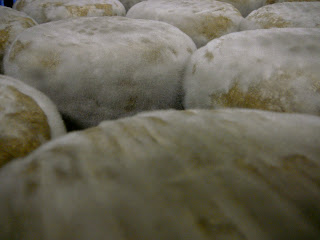In the morning we pour the milk into the big vat and pasteurize. Some Garrotxa is made with raw milk but Toni, owner of Formatge Bauma, has chosen to pasteurize. His philosophy is, 'the client will decide. If the client thinks our pasteurized cheeses are good, that's all that's important.' When the milk cools to 39˚C we add the ferments and the calcium chloride (a firming agent that helps the curds take; pasteurization harms the calcium naturally found in milk) and we wait a half hour.
The milk, still at 39˚C, is just in its beginning stage of transformation into cheese and we add the rennet. This will help the milk coagulate very quickly so that in as little as a half hour the curds and the whey will separate. This is when we cut the curds.
I'm not sure how long the curds are cut, actually. I'm either washing something or wrapping cheeses or just staring at the curds. Liviu, however, has worked at Formatge Bauma for eight years and has shown me how to determine when the curds are ready for draining. He tells me to dip my hand in, scoop out some curds, look at them and press them between my fingers. The curds should be about the size of the nail on my pinky finger and they should be slightly firm. That's when he knows they are ready to be poured into the draining table.
 Next the curds rest and are slightly pressed to release the whey. And then it's time to bring out the moulds! We slice the curd into square hunks that we hand-press into short round cylinders, larger cylinders, and bowls, depending on customer needs.
Next the curds rest and are slightly pressed to release the whey. And then it's time to bring out the moulds! We slice the curd into square hunks that we hand-press into short round cylinders, larger cylinders, and bowls, depending on customer needs. Finally, these cheeses are pressed only by their own weight and gravity.
The next morning we come back to find a very young Garrotxa. We take them out of their moulds to trim the extra bits, flip them, put them back in their moulds, and salt their exposed surfaces.
Here Toni and Merce work while talking in Catalan. Merce has been at Bauma for two years and no, I still don't understand Catalan. Ok, maybe some words.
After another 8 hours or so, we remove the cheeses entirely from the moulds, flip them, salt the other side, and put them in the drying room where they stay for about 24 hours. The moulds go to the wash and the final resting place for these Garrotxa cheeses is in the affinage room where they will grow a luxurious bluish-black rind. We hand-rub each cheese to limit unruly mold growth and flatten it down to keep the rind thin. Formatge Bauma Garrotxa feeds cheese-lovers in Spain, England, and even in the United States!








No comments:
Post a Comment